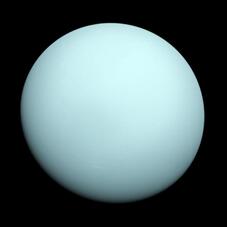URANUS
|
Uranus is the first planet to be discovered in modern times. It is mostly a ball of hydrogen covered by clouds of methane and water ice. Deep below the clouds there may be an ocean of super-hot liquid diamond! Uranus rotates backwards, like the planet Venus. The planet is tilted on its side, so that it “rolls” along its orbit around the sun. Bands of white methane clouds named “collars” circle the poles of Uranus during the spring and fall seasons.
|

